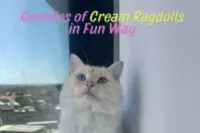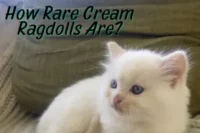Cream Ragdoll vs Lilac Ragdoll: Pastel Beauties Compared
Published: 29 Sep 2025
Did you know that Ragdoll cats come in some of the dreamiest pastel shades you’ll ever see on a kitty? One of our favorite parts of raising Ragdolls is watching their coats slowly blossom from snowy-white kittens into soft, colorful fluffballs. It feels like a little surprise gift as the weeks go by!
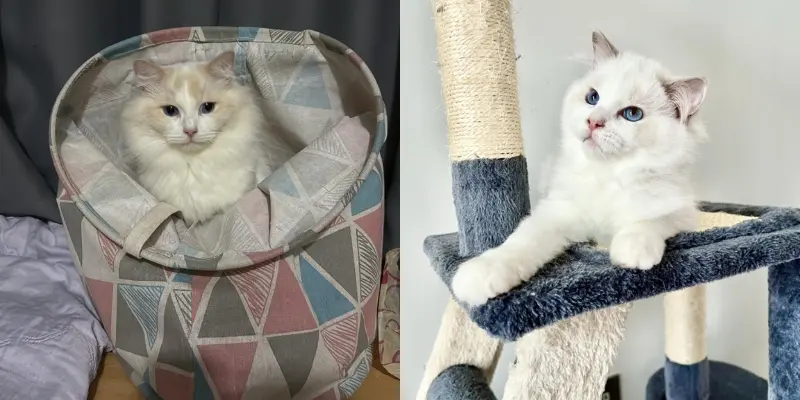
In this post, we are diving into two of the most delicate and enchanting shades: the Cream Ragdoll and the Lilac Ragdoll. We will chat about how they look, how their colors change as they grow and what makes each of them unique. If you have ever wondered whether your future cuddle buddy should be a peaches and cream sweetheart or a frosty-lilac fluff cloud, this guide will help you decide.
What is a Cream Ragdoll?
A Cream Ragdoll is one of the softest, sweetest-looking kitties you will ever meet. Their coat color is a dilute (or lighter) version of red which gives them that dreamy cream look. When we cuddle our Cream Ragdoll, it feels like holding a fluffy scoop of vanilla ice cream with a swirl of sunshine mixed in.
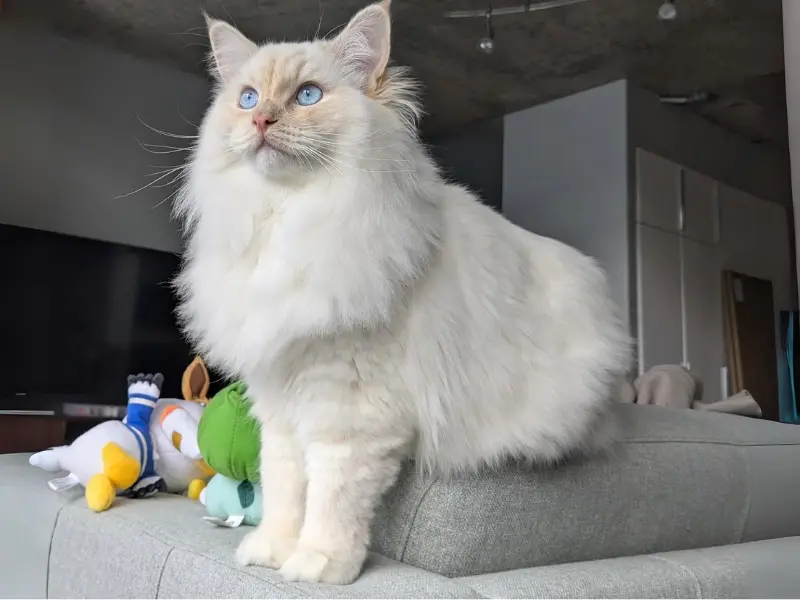
Most Cream Ragdolls are born pure white and their warm cream shades slowly appear as they grow. You will usually see the color deepen around their ears, face, tail and paws. These areas are called “points.” Depending on the pattern, Cream Ragdolls can come in:
- Colorpoint: cream points on ears, face, paws and tail with a lighter body.
- Mitted: cream points with adorable little white mittens and boots.
- Bicolor: A mix of cream points with a white inverted “V” on the face and more white across the body.
What makes Cream Ragdolls extra special is their soft, pastel glow. They often look warmer and slightly peachier than other light-colored Ragdolls which makes them stand out in the most subtle and charming way.
What is a Lilac Ragdoll?
A Lilac Ragdoll is like a little cloud of elegance and charm. Their coat color is the dilute version of chocolate which makes their fur appear as a soft, frosty gray with the tiniest hint of pinkish-lavender. When we first saw a Lilac Ragdoll, we couldn’t help but think they looked like a kitty wrapped in moonlight.
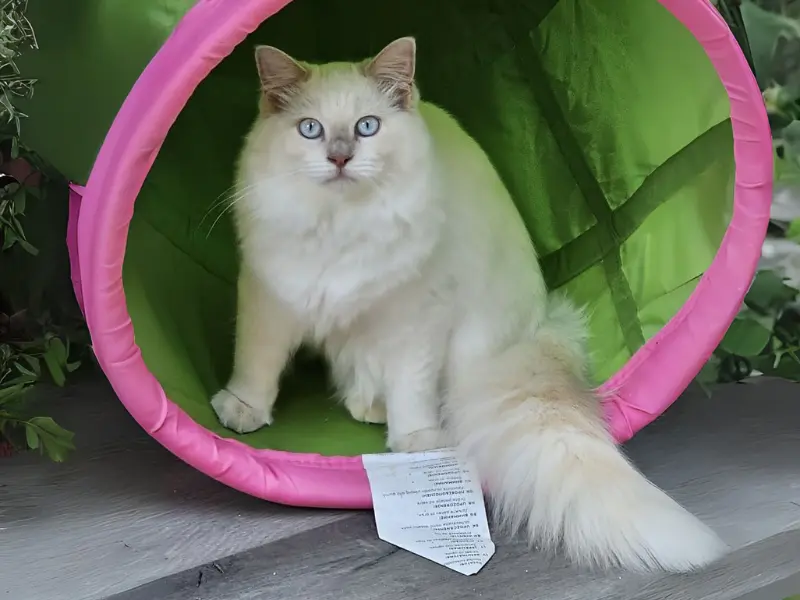
Just like Cream Ragdolls, Lilacs are also born pure white. Their delicate colors slowly blossom as they grow, usually showing up first on their face, ears, tail and paws. These “points” are what give them their signature pastel look. Depending on their pattern, Lilac Ragdolls can be:
- Colorpoint: pale lilac-gray points with a light, frosty body.
- Mitted: lilac points with sweet little white mittens and a chin patch.
- Bicolor: lilac points with a white “V” on the face and more white across the body.
What makes Lilac Ragdolls so enchanting is their cool-toned coat that always looks fresh and delicate. Compared to Cream Ragdolls, their overall look feels more frosty and elegant, almost like a soft lavender shadow drifting across their fur.
Appearance: Cream Ragdoll vs Lilac Ragdoll
One of the most exciting parts about comparing Cream and Lilac Ragdolls is noticing the little details that make each one unique. At first glance, both colors look light and dreamy but when you snuggle close, you will see the difference.
- Cream Ragdoll: Their coat leans toward warm and peachy-beige shades. Think of them as a soft scoop of peaches and cream coloured ice cream. Their points (ears, tail, face, paws) show warmer cream tones, while their body stays lighter.
- Lilac Ragdoll: Their coat has cool and frosty hues. Imagine a fluffy cloud dusted with pale gray and a whisper of lavender. Their points are lighter and cooler than the Cream’s, giving them a fresh and elegant look.
And let’s not forget the little extras!
- Nose leather and paw pads: Cream Ragdolls usually have pinkish tones while Lilacs carry a subtle lavender-gray shade.
- Eyes: Both have those classic deep blue Ragdoll eyes that make us melt every time we look at them.
So, if your cuddle buddy gives off warm sunshine vibes, you may have a Cream Ragdoll. If they remind you of a frosty morning sky, they are likely a Lilac. Isn’t it fun how their colors can tell such a sweet story?
Coat Color Changes: From Kitten to Adult
One of the magical things about raising Ragdolls is watching their coats transform as they grow. Both Cream and Lilac Ragdolls start out as snowy-white kittens and over time, their points develop into their true shades. It’s like unwrapping a fluffy surprise and we love every stage of the journey.
Cream Ragdoll Color Changes
- At birth: Cream Ragdoll kittens are born pure white, looking like tiny cotton balls.
- First few weeks: Their ears, nose and tail slowly begin to show a soft blush of cream.
- Around 3–6 months: The peachy points become more noticeable, especially on the face and tail.
- As adults (2–4 years): Their cream coloring fully blossoms, creating that pastel glow we adore.
Lilac Ragdoll Color Changes
- At birth: Lilac kittens are also born completely white with no visible points.
- First few weeks: Their points start to develop into pale gray tones with a whisper of pinkish-lavender.
- Around 3–6 months: The lilac points look delicate and frosty, contrasting with their lighter body.
- As adults (2–4 years): They maintain their silvery-lavender look which stays lighter than Cream Ragdolls.
Both colors can continue to deepen slightly until they are about 3–4 years old, so patience is key. We often remind new cat parents that their Ragdoll’s “final look” is a journey and each stage is as delightful as the next. Watching them change is truly part of the magic of being a Ragdoll parent.
Personality and Temperament
Here’s the sweet secret about Cream and Lilac Ragdolls, they may look different but their personalities are just as loving and floppy as any other Ragdoll. No matter the shade, these fluffballs are known for their gentle and affectionate nature.
- Calm cuddle buddies: Both Cream and Lilac Ragdolls love to flop in our arms like little rag dolls (that’s how the breed got its name!). They are usually happiest when lounging by our side or following us from room to room.
- Affectionate family cats: They are great with kids, gentle with other pets and thrive on companionship. We often joke that they are more like puppy-cats than typical felines.
- Playful but relaxed: While they enjoy playtime with feather toys or a good zoomie session, they tend to be calmer compared to more high-energy breeds.
Some cat parents feel that lighter-colored Ragdolls like Creams and Lilacs look extra soft and angelic but that’s just their appearance. When it comes to temperament both are equally sweet floppy cuddle clouds.
Rarity and Popularity
When it comes to coat colors, Cream and Lilac Ragdolls are like hidden treasures in the Ragdoll world. Both are considered less common than the classic seal ragdolls or blue shades which makes spotting one extra exciting.
- Cream Ragdolls: Creams are uncommon but not the rarest. You will sometimes find them with dedicated breeders who specialize in lighter shades. Their warm glow makes them a favorite for cat lovers who want something unique but still fairly accessible.
- Lilac Ragdolls: Lilacs, on the other hand, are quite rare. Their frosty look is highly prized, especially among show quality cats. Many breeders consider Lilacs to be one of the hardest colors to produce which adds to their exclusivity.
Because of their rarity, both Cream and Lilac Ragdolls are often seen as “special finds.” We like to think of them as little gems in the cat world where each one is as precious as it is beautiful.
Price and Adoption
Since both Cream and Lilac Ragdolls are less common than the classic seal or blue ragdolls, their price usually sits a bit higher. The exact cost depends on the breeder, the kitten’s pedigree and whether they are being sold as pets or for show and breeding.
- Cream Ragdolls: Generally, these fluffballs are priced slightly above standard colors. Their soft glow makes them desirable but they’re not as rare as Lilacs, so they are a touch more affordable.
- Lilac Ragdolls: Because they are rarer, Lilacs often come with a higher price tag. Their lavender gray points make them especially sought after and breeders may charge more for their exclusivity.
On average, you can expect to pay anywhere from $1,200 to $3,000 USD for a Cream or Lilac Ragdoll kitten, though Lilacs often lean toward the higher end. Show-quality kittens can cost even more.
For cat parents who prefer adoption, it’s always worth checking local shelters or Ragdoll-specific rescues. While rare colors like Cream and Lilac don’t pop up often, when they do, it feels like finding a little unicorn in the adoption world.
Which is Right for You?
So, how do you decide between a Cream Ragdoll and a Lilac Ragdoll? The truth is, you really can’t go wrong because both are fluffy bundles of love. Still, their colors do give off slightly different vibes.
- Cream Ragdoll: If you are drawn to warm and sunshine-kissed tones, a Cream Ragdoll might be your purr-fect match. They have that soft, peaches and cream glow that feels cozy and cheerful.
- Lilac Ragdoll: If you love cool and frosty shades with a touch of elegance, a Lilac Ragdoll may steal your heart. Their silvery-lavender look gives them an air of dreamy sophistication.
At the end of the day, personality-wise, they are equally floppy, affectionate and sweet. It really comes down to whether you picture your cuddle buddy as a warm peachy fluffball or a frosty lavender cloud. Either way, you will be gaining a loyal companion who fills your home with love and purrs.
Conclusion
Whether you fall for the warm glow of a Cream Ragdoll or the lavender elegance of a Lilac Ragdoll, one thing is certain—both bring endless joy, cuddles and gentle companionship into our lives. These pastel beauties may look different but their hearts are full of the same Ragdoll love we all adore.
Choosing between them is not really about personality, since they are equally sweet and floppy. It’s about which color makes your heart skip a beat. Do you dream of a peaches and cream cuddle buddy or a silvery-lavender cloud of fluff? Either way, you are welcoming a little piece of purr-fection into your family.
More Fur Qur
Here is the list of frequently asked questions:
Cream Ragdolls have war and peachy-beige points while Lilacs have cool and frosty gray points with a hint of lavender. Their paw pads and noses also help in which Creams usually have pink tones while Lilacs often have soft lavender-gray.
Yes! Both are born pure white. Creams slowly develop peachy tones while Lilacs grow into pale gray with lavender hues. Their full adult colors usually show by 3–4 years old.
Lilac Ragdolls are rarer than Creams. Breeders often consider them one of the hardest colors to produce which is why they are less common and usually more expensive.
Not at all. Their color does not affect their temperament. Both are classic Ragdolls with gentle, affectionate and floppy nature.
Yes, usually. Creams cost slightly more than common colors like seal or blue. Lilacs are rarer, so they often come with a higher price tag, especially for show-quality kittens.
It’s possible but rare. Most rescues see more common Ragdoll colors. Still, keeping an eye on breed specific rescues or adoption groups may reward you with a surprise pastel fluffball.

- Be Respectful
- Stay Relevant
- Stay Positive
- True Feedback
- Encourage Discussion
- Avoid Spamming
- No Fake News
- Don't Copy-Paste
- No Personal Attacks



- Be Respectful
- Stay Relevant
- Stay Positive
- True Feedback
- Encourage Discussion
- Avoid Spamming
- No Fake News
- Don't Copy-Paste
- No Personal Attacks



